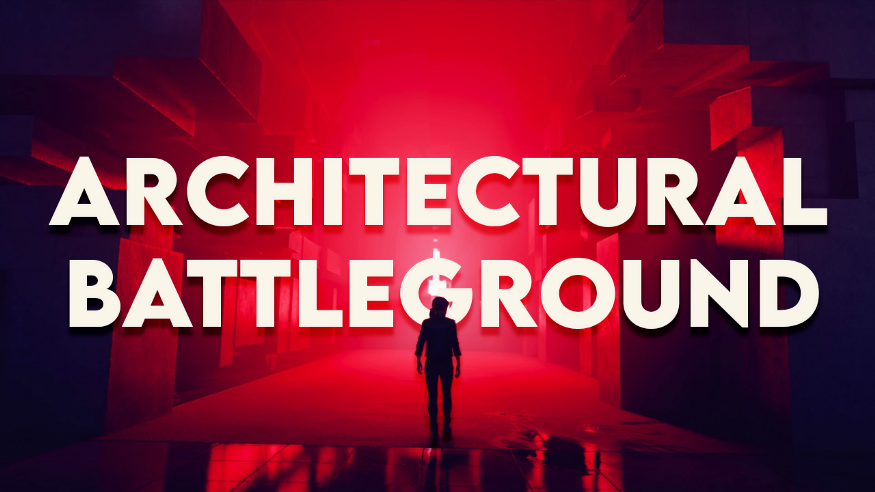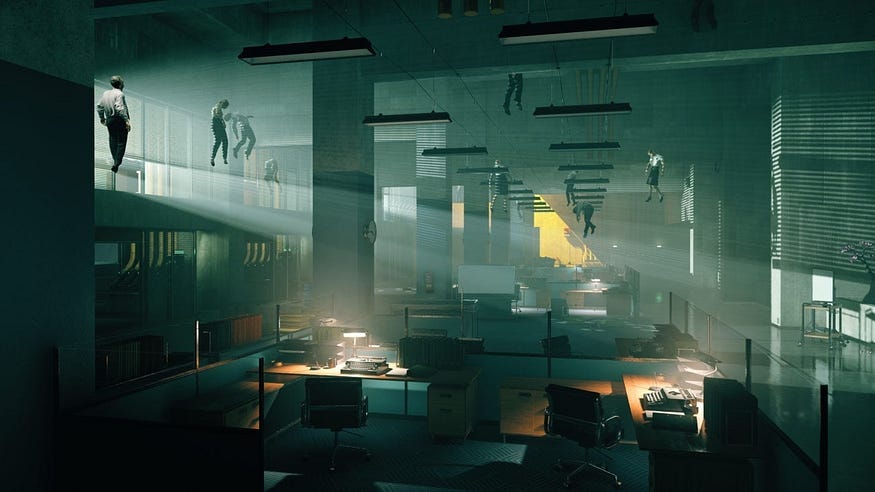The Architectural Battleground of Control
Control’s ‘Oldest House’ is a haunted labyrinth of Brutalist architecture. But why delve into a long-dead architectural style?

You’d think a government office building made almost entirely out of concrete would be a boring setting for a game, but Control turns that on its head with the Oldest House.
Crafted in a brutalist architectural style, the secret government headquarters known as the Oldest House offers some of the most striking and unique visual design in the industry.
Post-War Architecture
Brutalism and brutalist architecture emerged during the extensive reconstruction projects of the post-war period, characterised by bare concrete and monolithic appearance. Remedy took direct inspiration from real-world examples when designing Control’s brutalist labyrinth, from the Long Lines building in Lower Manhattan to Boston City Hall. The style began to decline in the 1970s, however, having been criticised as unwelcoming and inhuman. Yet if brutalism died in real life, it certainly lives on in Control. Criticisms of the style as unwelcoming and inhuman may be negative in the real world, but it’s perfectly at home as the foundations of the Oldest House.
This article can also be found as a video on my YouTube channel.
Long Live Brutalism
The Oldest House is synonymous with exposed concrete, which borders every room. Besides the front door there are no sources of natural light. Instead, light floods in from artificial sources like monolithic light blocks built into the very ceiling, exposing areas in a controlled yet beautiful glow. Doorways are lined by mesmerising geometric patterns creating ritualistic ascending entranceways. The visual design of Control feels unnatural and claustrophobic with its adherence to ritualistic patterns and controlled lighting.

While simple and clear-cut, however, it’s by no means devoid of style or substance. It may not have the extreme detail of The Last of Us but it doesn’t need it. Sometimes less is more, and Remedy certainly understood this. Control is stunning precisely because of its simplicity. The simple design of the walls and floors with repeating patterns draws importance to the foreboding monolithic structures, the intense and stylistic lighting, and the unnerving but captivating atmosphere as you delve into the labyrinth that is the Oldest House. This stems from approaching the visual design “as if it was a church, with a clear centre, an altar or plinth”, as Art Director Janne Pulkkinen explains. This philosophy is part of what makes Control’s visual style so transcendental with its large, symmetrical atriums and monolithic structures bathing in a stark glow. It gives each and every room a grandiose feel that is genuinely breath-taking to experience.

Architecture Supporting Gameplay
The cleanness of Control’s visual style also serves its gameplay. Environments may be clean and geometric, but combat can get messy. Enemies shift around with a variety of unique effects, and Jessie’s superpowers pull apart foundations. The simple design of the environments gives way to impressively detailed and stylistic effects in combat that may otherwise be overwhelming. As World Design Director Stuart Macdonald puts it, “the mundanity of the space is important, because 10 seconds later everything’s going to be trashed, and there’s going to be chaos.” In this way, concrete’s simple textures allows for greater style and chaos in gameplay.
The Twisted Concrete Labyrinth
The setting of a secretive government agency goes hand in hand with brutalist architecture and explains the game’s visual consistency. Simply put, it’s very believable that a government building would reuse styles and layouts. It never bothered me that Control’s visuals were 90% concrete, 8% floating bodies, and 2% polished wood. Well, that’s what it feels like, in reality it’s ‘only’ about 75% of Control’s tileable materials are concrete. Nevertheless, it’s oddly beautiful to emerge out of a long dark hallway into a grand hall occupied by a single tree and flooding white light, or an engine room painted in a heavenly orange glow. Senior Environment Artist, Miro Vesterinen, detailed how Remedy went about creating a wide array of concrete textures, from ones with pores and cracks, to ones with rough surfaces, since concrete would dominate the environmental design.
While brutalism explains the visual consistency, supernaturalism explains the shifting environments contained inside the Oldest House. The clash of the supernatural with the mundane is vital to Control’s style. You’ll go from cramped office space to sweeping, monolithic halls or twisting corridors, making it clear that the Oldest House was not designed to be a cosy workplace; it’s unnerving and unwelcoming. In fact, the Oldest House technically wasn’t ‘designed’ by humans at all, no one really knows how it began, all we know is that it’s ran by ‘The Board’. The ever-shifting bowels of the Oldest House, transforming right before your very eyes, should say as much. We’re not supposed to be there. The building controls itself and it doesn’t care about the people inside. Rooms appear where walls once stood, inviting you deeper into its depths. Even bathrooms aren’t safe from the shifting world contained within the Oldest House.
Seeing the building react to your presence visually, such as the paintings of the Director changing to Jesse once you acquire the service weapon, a photo that shouldn’t even be able to exist, is a great detail in highlighting the inhuman forces at play. The Oldest House isn’t just any normal building and it shows in its foreboding atriums, its twisting corridors, and its striking monolithic structures that dominate the landscape.

Architectural Battleground
At the heart of Control’s visual design, however, is a conflict. A conflict between order and chaos; brutalism and the invasive supernatural forces. The brutalist architecture is controlled, strict, and geometric, representing security and order, while the supernatural forces invading the Oldest House don’t follow such comprehensible rules. The enigmatic Hiss corrupt the world. They transform even the very building itself, breaking down the order expressed in the architecture. Brutalism is no match for the unknown. Yet order can be restored, literally and in a more abstract sense.
The ‘control points' found around the Oldest House act as checkpoints for the player, but only once the corruption of the Hiss has been removed. Here, you’ll fight the Hiss face to face and eliminate them to cleanse the point of their influence, making the area safe and therefore restoring order. But there’s more to the design of this feature. The corrupted control points represent the very essence of the Hiss through the visual design of the spaces. The walls are shifted out of place to break the strict layouts, and whole rooms and doorways cease to exist where they once did.
Once Jesse has cleansed them, however, order is also restored to the architecture, reverting back to the brutalist straight lines and geometric shapes, reorganising the rooms back to their original form. It’s an excellent way of conveying thematic ideas visually and creatively. Order could have been restored simply by removing the physical Hiss threat, but Remedy took it up a notch by using the very architecture to illustrate the conflict.
In the end, it may not be the most detailed or traditionally beautiful game with its repeating concrete environments, but Control is a masterclass in marrying visual design with thematic concepts and story. The brutalist style represents order and resilience against supernatural forces that seek to disrupt it. I’d love to see more games explore this method of story telling and design, as it certainly has a powerful impact on Control’s captivating atmosphere.
More 1-UP!
Sources
- Environment and Material Creation of Control by Adobe: https://www.youtube.com/watch?v=C4sZHMpsYEQ
- Eurogamer: https://www.eurogamer.net/articles/2019-09-03-remedys-control-is-built-on-concrete-foundations
- NYC Urbanism: https://www.nycurbanism.com/brutalnyc/att-long-lines-building
- Adobe Substance: https://magazine.substance3d.com/control-how-one-senior-environment-artist-created-entire-brutalist-material-library/
